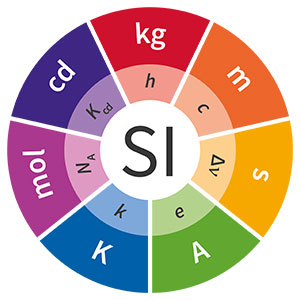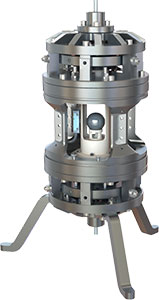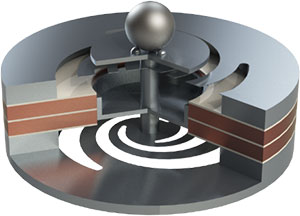 More accurate measurement facilitates advances in science and technology, which in turn allows more accurate measurement. These improvements in accuracy must be underpinned by stable measurement standards and agreed definitions of measurement units. NPL is working to continuously improve the realisation and dissemination of the SI units. To do this we work in close collaboration with other National Metrology Institutes, as well as leading researchers in this area.
More accurate measurement facilitates advances in science and technology, which in turn allows more accurate measurement. These improvements in accuracy must be underpinned by stable measurement standards and agreed definitions of measurement units. NPL is working to continuously improve the realisation and dissemination of the SI units. To do this we work in close collaboration with other National Metrology Institutes, as well as leading researchers in this area.
The SI unit of mass, the kilogram, underwent a fundamental change to its definition in 2019. The kilogram is now defined in terms of a fixed value of the Planck constant, a fundamental constant of nature. This will ensure the long-term stability of the unit of mass which could not be guaranteed with a definition based on a physical artefact.
 There are currently two types of experiment which have the capability to realise the new kilogram to the required accuracy. One relates the kilogram to very accurate quantum electrical standards. It balances a standard weight against the force generated by a coil carrying an accurately defined current in a magnetic field, like a loudspeaker. This apparatus is known as the Kibble balance as it was originally devised by Dr Bryan Kibble in the 1970s at NPL. The other method, known as the Avogadro experiment, uses a sphere of single crystal silicon.
There are currently two types of experiment which have the capability to realise the new kilogram to the required accuracy. One relates the kilogram to very accurate quantum electrical standards. It balances a standard weight against the force generated by a coil carrying an accurately defined current in a magnetic field, like a loudspeaker. This apparatus is known as the Kibble balance as it was originally devised by Dr Bryan Kibble in the 1970s at NPL. The other method, known as the Avogadro experiment, uses a sphere of single crystal silicon.
By making measurements of the volume, lattice spacing (how far the atoms are apart) and the isotopic composition of the silicon (which types of silicon atoms make up the crystal), the mass of the sphere can be determined and used to define the SI unit of mass. The current accuracy of these experiments in about 1 part in 100 million, which is the equivalent to the weight of 1/500th the weight of a grain of sand on a mass of 1 kilogram.
 NPL has designed and is currently building a next-generation Kibble balance to maintain and disseminate the ‘new’ SI unit of mass. The Kibble balance is one of the methods which can be used to realise the redefined kilogram. Existing Kibble balance experiments at other national measurement institutes (NMIs) have been designed to measure the Planck constant, this being necessary for the redefinition of the kilogram. There is now a need for a simpler, but equally accurate, apparatus to realise the new kilogram and NPL is leading a collaboration of NMIs developing such an instrument.
NPL has designed and is currently building a next-generation Kibble balance to maintain and disseminate the ‘new’ SI unit of mass. The Kibble balance is one of the methods which can be used to realise the redefined kilogram. Existing Kibble balance experiments at other national measurement institutes (NMIs) have been designed to measure the Planck constant, this being necessary for the redefinition of the kilogram. There is now a need for a simpler, but equally accurate, apparatus to realise the new kilogram and NPL is leading a collaboration of NMIs developing such an instrument.
A benefit of the new definition of the kilogram is that there is the opportunity to realise the SI unit of mass anywhere in the world and at any mass value. As well as developing a ‘full-sized’ Kibble balance to realise the kilogram NPL is also working on micro-Kibble balances to measure very small masses and forces. Such balances will improve measurements for applications such as pharmaceutical research and drug production including personalised medicine, micro-robotics and micro-fabrication and environmental monitoring.
The 2019 update to the SI contained the first major change to the metre definition since 1983 when the metre was redefined in terms of the fundamental constant, c, the speed of light.
An expanded Mise en Pratique (MeP) document was written, as the previous document included only a list of approved absorption lines and hence frequencies of light that could be used. The new MeP gives details of the two main methods for length realisation: time of flight and optical interferometry. However, the major addition is the introduction of the lattice parameter of silicon as a secondary realisation of the metre for dimensional nanometrology. This was proposed by the Consultative Committee for Length’s Working Group for Nanometrology, which is chaired by NPL.
Three routes for use of the silicon lattice parameter have been recognised: x-ray interferometry, transmission electron microscopy and mono atomic silicon steps on silicon substrates for the calibration of atomic force microscopes. NPL is active in two of these areas: x-ray interferometry and atomic force microscopy.
Through a longstanding collaboration with PTB, NPL has developed x-ray interferometry into a metrological tool for the characterisation of nano displacement sensors including optical interferometers. NPL is currently working towards making the technique more robust and developing the capability for positioning with picometre accuracy.
In collaboration with several other European NMIs, NPL has assessed the potential for using monoatomic silicon steps for calibration of the topography axis of scanning probe microscopes. Further work is underway to determine the uncertainties associated with these samples and to characterise errors in nanopositioning and systems and scanning probe microscopes.
The current definition of the SI second is based on assigning a fixed value to a transition frequency in caesium atoms. Whilst this definition is exact, the practical realisation is currently limited to an uncertainty of 1 part in 1016 by technical challenges in caesium clocks. There are other atomic species, however, with optical transitions for which the technical challenges can be controlled to give a frequency uncertainty of just 1 part in 1018. It is therefore considered that the second should be redefined in terms of an optical transition.
But which atomic species should be chosen? There are several candidates and no clear winner at this stage. The international community is therefore working to gather more data by measuring different optical clocks relative to each other, including comparisons between clocks in different countries. This raises a new challenge of how to make accurate comparisons between distant clocks since the best devices are not portable, but fixed experimental setups that fill an entire laboratory. So more research is still needed, both with optical clocks and the links between them, before we can be ready for a redefinition of the SI second.
The change that the 2019 SI redefinition brought to the electrical metrology was mainly conceptual. Prior to the redefinition, because of the difficulty in the experimental realisation of the ampere, the metrology community adopted a conventional unit system that took agreed values of the Josephson and von-Klitzing constants (KJ-90 and RK-90) for the realisations of volt and ohm, respectively. The ampere was derived from the volt and ohm. While this worked in practice, it was conceptually an awkward situation as the realisation of the ampere, one of the base SI units, depended on the conventional realisations of the volt and ohm.
After the 2019 redefinition, the values of e and h were fixed, the Josephson-voltage (KJ = 2e/h) and quantum-Hall-resistance (RK = h/e2) standards are considered to provide true realisations of SI volt and ohm, respectively. In practice, the ampere still has to be derived from the volt and ohm, but the awkwardness is lifted, as the direct traceability to the definition of the physical constants can be maintained.
In future, an accurate single-electron-transfer device, which does not yet exist at the required level of accuracy, might be able to realise the ampere. So, eventually, the three electrical units will be able to be realised independently. Then a question arises: ‘Are they consistent?’. If they are consistent, the three units should close a so-called quantum metrological triangle. If there are hidden errors in the realisations of units, then the triangle will not close.
While it is generally believed that the realisations by Josephson and quantum Hall standards are accurate, it is not yet known whether small corrections need to be applied to their realisation. In order to test this properly by quantum metrological triangle, the accuracy of single-electron current standards needs to be at a level of 1 part in 108. The present accuracy record is roughly at 2 parts in 107, so an improvement with more than one order of magnitude is required. NPL is working towards this target, and once a consistency test by quantum metrological triangle becomes available, we will be able to say that we have a truly robust system of electrical metrology.
Find out more about NPL’s work on Quantum electrical standards
NPL is leading a 21 partner EMPIR project ‘Realising the redefined kelvin’ (Real-K) which aims to take advantage of the kelvin redefinition by developing primary thermometry to the point where it can be used, in some temperature ranges, to provide traceability directly to the redefined kelvin.
Currently around the world temperature traceability is taken from one of two defined scales, the International Temperature Scale of 1990 (ITS-90) or the specialist low temperature scale the Provisional Low Temperature Scale of 2000 (PLTS-2000). The long term aim of this activity is that practical primary thermometry will increasingly be adopted, decreasing reliance on traceability to defined scales and improving the long-term reliability of measurements.
By the mid-2020s, the low temperature part of the current scales (below 25 K) could be replaced with simpler primary thermometry approaches, whilst the high temperature part of ITS-90 (above 1300 K) will be replaced by more robust indirect primary radiometry.
Specific NPL contributions to Real-K are:
NPL is working with other organisations to determine experimentally low uncertainty values of the thermophysical properties of gases, specifically in NPL’s case Argon. This work will reduce the uncertainty and broaden the range of gas based primary thermometry for temperature realisation and dissemination above 25 K.
The Real-K consortium, led by NPL, will propose a number of recommendations to the Consultative Committee for Thermometry (CCT) on how to ensure an effective transition from the defined scales to primary thermometry whilst maintaining the integrity of temperature traceability around the world.
Besides the Real-K activities we are also performing unique world-leading primary acoustic thermometry to determine the thermodynamic fitness of the current temperature scale in use around the world, the ITS-90, at temperatures above 300 K.
We are also helping a number of NMI’s around the world establish leading acoustic thermometry capability to enable them to derive traceability directly to the redefined kelvin. In parallel, we are also collaborating with an instrumentation development company to develop a practical primary ‘Johnson noise’ thermometer which, when commercialised, will enable end users to make direct temperature measurements, independent of a temperature scale and independent of any calibration.
Most practical uses of the mole relate to describing the composition of mixtures – this is as true after the redefinition as it was before. One important characteristic of the mixture of gases in the atmosphere is the ratio of naturally occurring stable isotopes. Realising isotope ratio with a robust infrastructure is essential in enabling the global efforts towards tackling climate change. Underpinning measurements of stable isotopes of key greenhouse gases, which infer their origin, provides the means to discriminate anthropogenic from natural contributions and discern emissions from different industrial sectors. This will provide governments with the data required to support inventory verification targets and enable pledges of emissions reductions to be demonstrated. However, isotope ratio remains the only traceability exception in chemistry under the CIPM Mutual Recognition Arrangement.
There has been a significant research effort to set up a metrological infrastructure to provide traceable measurements of isotope ratio of greenhouse gases to primary scales. When probing the isotopic composition of gases, relative methods are applied with the necessity of a well-characterised reference. The stable isotope reference material for oxygen and carbon, NBS 19, was developed from a white marble slab of unknown origin and was used to define the primary VPDB scale. In 2006, new guidelines were published for d13C calibration, including a recommendation to additionally use an assigned d13C value for the LSVEC (lithium carbonate) reference material to obtain an improved two-point calibration. NBS 19 is now exhausted, and LSVEC has suffered stability issues, both posing serious challenges to maintaining continuity to the primary scale and reducing offsets between laboratories from calibration. The International Atomic Energy Agency has since developed IAEA-603, a new primary reference material, although an additional component of uncertainty is now required to link to the scale defining material, NBS 19.
This practical realisation using carbonates is far from ideal and requires intricate processing steps leading to systematic biases between laboratories. Transferring the scale into other matrices, such as carbon dioxide in air (required for atmospheric monitoring), maintained by several NMIs, is a current research focus for NPL, to resolve the issues which have existed for decades and provide lager volumes of reference material to meet the calibration demand from the widespread deployment of optical spectroscopy at monitoring stations.
For carbon dioxide, no absolute isotope ratio measurements traceable to the SI have been achieved with the desired uncertainty due to insufficient methods, materials and instrumentation. NPL is leading research efforts in Europe, to progress beyond the state of the art by testing and verifying new methods to determine absolute values of isotope ratios for 13C-CO2 and 18O-CO2 to put measurements on an SI-basis for the first time. This will lead to a more robust measurement infrastructure, ensuring results are comparable, stable and coherent.
The candela is the SI unit of luminous intensity in a given direction; it measures the visual intensity of light sources, i.e. weighted by the spectral response of the human eye, and is the only SI base unit based on human perception. In 2019 when other units were redefined, the only change to the candela was an update to the mise-en-pratique for its realisation and for the related radiometric quantities and their usage.
Today our active research effort is mostly in the related and generic field of radiometry – the measurement of the physical power of optical radiation i.e. visible light, ultraviolet and infrared; rather than photometry which measures the human eye response to visible light only. All radiometry and photometry measurements, including the candela, are traceable to the cryogenic radiometer which is an instrument that measures the power in a light source (often a laser) by absorbing the light in a cavity and comparing the temperature rise due to optical heating with that due to electrical heating. By operating at cryogenic temperatures, the radiometer is far more sensitive than similar devices at room temperature and the sources of uncertainty are significantly reduced. NPL pioneered the development of cryogenic radiometry 35 years ago and it is now the primary standard of choice across the world’s national metrology institutes.
Our major research effort is focused on improving the understanding and monitoring of the Earth and environment, particularly where it is impacted by climate change. Remote observation of incoming and reflected sunlight and emitted thermal infrared radiation from the Earth’s surface and atmosphere by satellites is the principle source of information for society on the health of the planet. Calibration and validation of these satellite sensors, both pre-launch and in-orbit, is our current priority. A recent development is the new STAR-cc-OGSE (Spectroscopically-Tuneable Absolute Radiometric, calibration and characterisation, Optical Ground Support Equipment) tuneable laser system, which has been developed in partnership with the innovative UK company M Squared Lasers and which uniquely addresses a full set calibration and characterisation needs of the prelaunch calibration of an optical-imaging sensor at any wavelength from ~260 nm – 2700 nm with full SI-traceability to the cryogenic radiometer. We also operate several ground sites where the spectral and angular reflectance properties of both desert surfaces and vegetated/forested landscapes can be monitored through field campaigns and permanent instrumentation for comparison with satellite sensors.
Our most ambitious project, however, is the TRUTHS satellite, which is a climate and calibration mission, conceived by NPL and led by the UK Space Agency that will be implemented by the European Space Agency and is currently under development. TRUTHS stands for Traceable Radiometry Underpinning Terrestrial- and Helio- Studies and the satellite will fly a cryogenic radiometer, and a space equivalent of the STAR facility, to calibrate its on-board camera. TRUTHS will be the first satellite to fly an SI-primary standard in space, in effect establishing a ‘metrology lab in space’. The mission will enable a10-fold improvement in the accuracy of Earth observation data, to provide a climate benchmark of the state of the planet from which to monitor change. It can also be used to cross-calibrate other satellite sensors from orbit, so upgrading the existing Earth observation fleet by ensuring long-term traceability and confidence in the data produced.